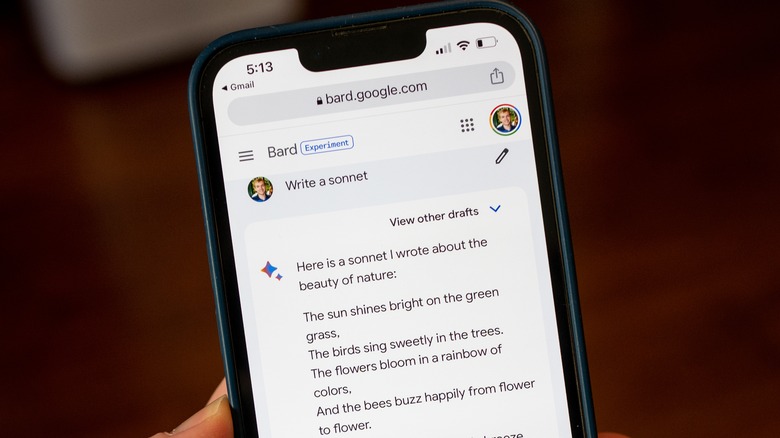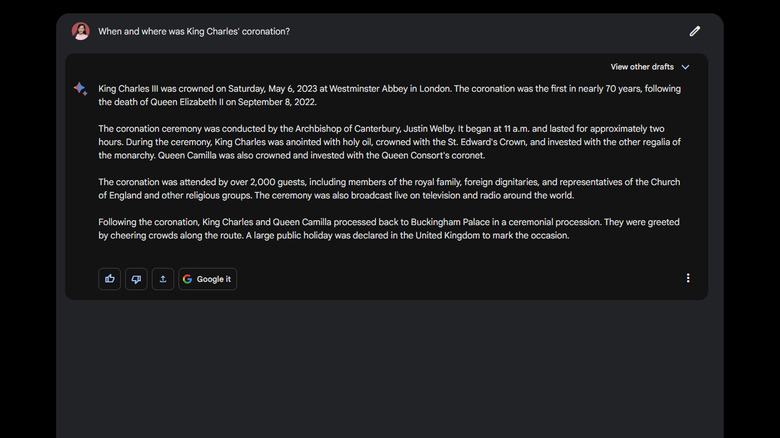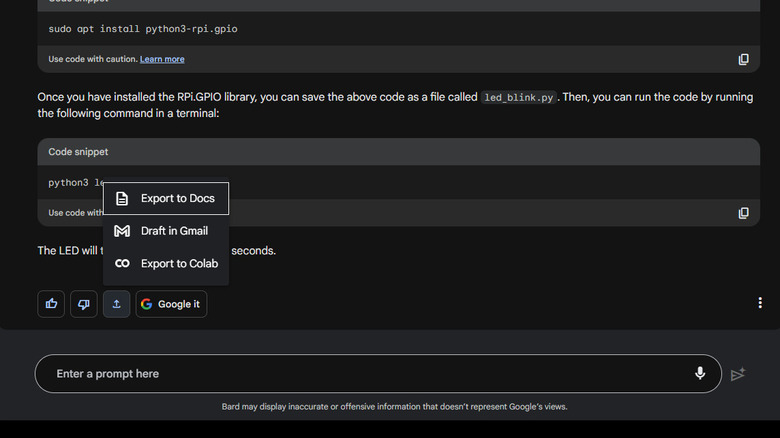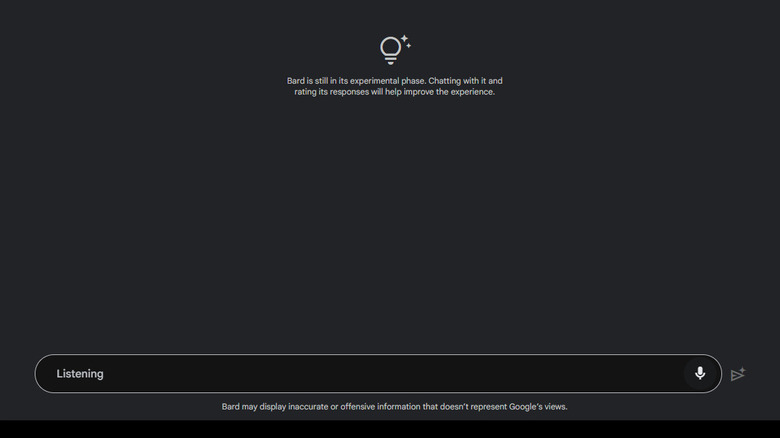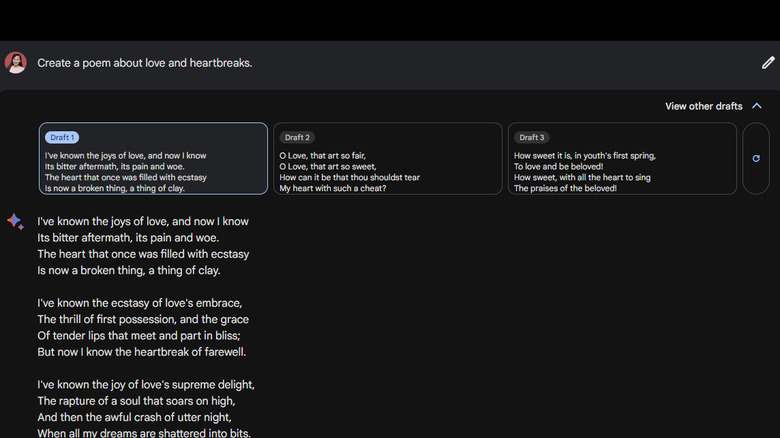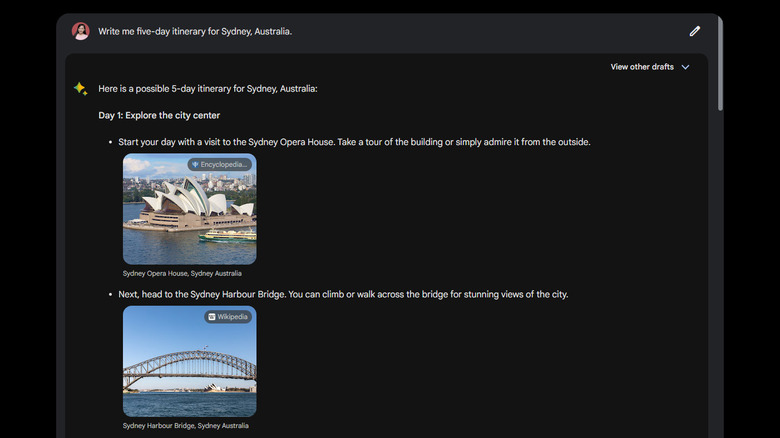5 Reasons You Should Use Google Bard Instead Of ChatGPT
When OpenAI's artificial intelligence chatbot, ChatGPT, launched in late 2022, it quickly gained a massive audience — in fact, it reached a million users less than a week after its release. This comes as no surprise, though, considering how helpful the chatbot has been in a wide variety of tasks, including Excel formula generation and essay rewrites.
Unfortunately, despite the many tricks it has up its sleeves, ChatGPT also has several limitations when compared to the other recently emerging AI-powered chatbots. One particular competitor is Bard, Google's version of a conversational AI. Launched in February 2023, Bard is a free platform much like ChatGPT. While it's still under development, it already comes with a handful of nifty features that OpenAI's chatbot isn't capable of yet. If you're torn on what AI tool to use, we've compiled five of the best reasons why you should go for Google Bard instead of ChatGPT.
Access to real-time and online information
An AI chatbot's response to a user's query significantly depends on the data it was trained on and currently has access to. Unfortunately, the free version of ChatGPT is limited to training data dating up to September 2021. This means that if you ask the chatbot questions about events after that date, it will most likely give you inaccurate results or tell you that it can't answer due to the limitations of its training data.
That's one of the major differences between Google Bard and ChatGPT: the former is capable of responding with updated and fresh information as it can connect to the internet. Ask it anything you want, and it will reply with real-time data, sometimes even citing the online resources it used. With Google Bard's web connectivity, you can also access online documents as long as they are publicly viewable. This can come in handy when you want to summarize a research paper or get the key insights from an online PDF without having to paste the entire document into the chatbox.
To be fair, ChatGPT does come with web browsing capabilities, but it's only available on the Plus account that you'd need to subscribe to for $20 per month. If you're after a more budget-friendly option, Google Bard is the way to go.
Integration with Google Search and productivity tools
When you need to verify a ChatGPT response, you have to hop on a new browser tab and copy and paste the text to your search engine of choice. With Google Bard, all it takes is two simple clicks. That's because the Google chatbot comes with integration with Google Search, making it a lot quicker to verify the AI responses or get more information about your query. You simply need to click on the Google It button at the bottom of the response, and you'll get a couple of "search-related topics" to choose from. Clicking any one of these topics will automatically bring you to a Google Search page about the topic.
Similarly, you can export Google Bard's responses directly to other Google productivity tools and services like Google Docs, Sheets, Gmail, and Google Colab. When creating letters, tables, emails, or codes with Bard, just click "Export to Docs/Sheets," "Draft in Gmail," or "Export to Colab," and the AI-generated response will automatically be transferred to that specific service. No more opening a new tab and pasting the content manually.
Audio prompt support
Unlike ChatGPT, which can only accept written prompts, Google Bard has support for both written and spoken inputs. It features access to your device's microphone, allowing you to use your voice to interact with the AI chatbot. Just click on the mic icon, say your prompt, watch Bard transcribe it for you, and get your response. This makes the Google chatbot more accessible and user-friendly, especially to those who can't physically use a mouse and keyboard.
You can use audio inputs like how you would text prompts. For instance, instead of typing your request, you can talk with Bard to ask for information about recent news, have it write a Facebook caption for a store anniversary, or let it draft code for your Raspberry Pi. Bard's audio prompts can also be of use for translating languages. However, as of this writing, it's limited to three languages: U.S. English, Korean, and Japanese. The developers are actively working on adding more options, so you might get to use additional languages with the chatbot in the future.
Automatic draft creation
One thing that separates ChatGPT from Google Bard is the number of responses it provides users with for each prompt. With ChatGPT, every time you send a prompt, you will only get one response back. If you're not satisfied with the first answer, you'd need to click on "Regenerate response" to get another one.
With Google Bard, however, you automatically get three responses (called "drafts") with each prompt. You won't have to regenerate a new response over and over again as you immediately have three answers you can choose from. If you can't find what you're looking for in these first three responses, you can still regenerate new drafts (each regeneration offers three drafts, too). However, while this is a faster way to get the answers you need, a downside of this feature is that you can't go back to the previously created drafts once you regenerate a new set.
Image support in responses (and soon, prompts)
There are just some prompts that are better with pictures. Let's say you need a list of the required hand tools to make a wooden coffee table. If you're a visual person (and have little to no knowledge about hand tools), you'll definitely appreciate getting images in the AI-generated responses. Fortunately, Google Bard comes with such a feature. In its May 23, 2023, update, it started integrating images into the responses it gives users. The photos come with source links, so you can easily download or verify them.
To ask Google Bard for images, you can directly say so in your prompt. For instance, "Give me a list of family-friendly dog breeds and their pictures." Google Bard can also automatically insert photos even without you explicitly requesting it. This typically applies to prompts involving places, animals, natural scenery, art pieces, and the like. Aside from images in responses, developers of Google Bard also plan on supporting photos in the prompts.
